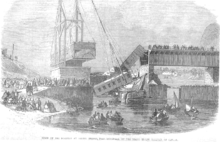St-Hilaire train disaster
The St-Hilaire train disaster occurred on June 29, 1864, near the present-day town of Mont-Saint-Hilaire, Quebec. The train, which was carrying many German and Polish immigrants, fell through an open swing bridge into the Richelieu River after the crew failed to obey a stop signal. Though uncertain, the widely accepted death toll is 99 people.[1] The disaster remains the worst railway accident in Canadian history.[2][3]
| St-Hilaire train disaster | |
|---|---|
 | |
| Details | |
| Date | June 29, 1864 1:20 a.m. |
| Location | Otterburn Park, near Mont-Saint-Hilaire, Quebec |
| Country | Province of Canada |
| Line | Grand Trunk Railway |
| Incident type | Swing bridge open |
| Cause | Signal passed at danger |
| Statistics | |
| Passengers | 354–475 |
| Deaths | 99 |
| Injuries | 100 |
Background
During the 19th century, the Richelieu River served as an important waterway for trade between New York City and Montreal. Tourism also developed in the area greatly due to the steamboats that travelled up and down the river. The Belœil Bridge was built as a swing bridge so that the railway would not interrupt the shipping lanes.[4] The bridge connects the present-day municipalities of Otterburn Park, on the river's east bank, with McMasterville, on its west bank. Other nearby municipalities are Mont-St-Hilaire, on the east bank, and Beloeil, on the west bank.
Disaster
On June 29, 1864, a Grand Trunk train carrying between 354 and 475 passengers, many of them German and Polish immigrants, was travelling from Quebec City to Montreal.[2][5] At around 1:20 a.m. local time the train was approaching the Belœil Bridge.[6] The swing bridge had been opened to allow the passage of five barges and a steamer ship. A red light 1.6 km (1 mi) ahead of the bridge signalled to the train that the crossing was open and it needed to slow.[5] However, the light was not acknowledged by the conductor, Thomas Finn, or the engineer, William Burnie, and the train continued towards the bridge[6][7] from the east.

At 1:20 a.m. the train came onto the bridge and fell through an open gap. The engine and eleven coaches fell through the gap one after another on top of each other, crushing a passing barge. The train sank into an area of the river with a depth of 3 metres (10 ft).[2] 99 people aboard the train were killed and 100 more were injured.[2] Among the dead were Thomas Finn and the fireman aboard the train. The engineer was slightly hurt, but was able to escape the wreck.
Response
The Grand Trunk Railway sent large numbers of men to assist the recovery and rescue efforts. The rescue effort was supported by members of the German Society of Montreal, the St. George's Society of Montreal, the St. Patrick's Society of Montreal and the Irish Protestant Benevolent Society of Montreal.[8] The hospitals and other institutions in nearby Montreal were used for the injured passengers. The dead were also brought to Montreal and buried in the Mount Royal and Roman Catholic cemeteries.[9]
Aftermath
The Grand Trunk Railway tried to blame the disaster on the conductor and engineer for failing to obey the standing order to stop before crossing the bridge. The engineer, who had only recently been hired, claimed that he was not familiar with the route and that he did not see the signal.[6][7]
On October 5, 1864, a grand jury placed full responsibility for the disaster on the Grand Trunk Railway for negligence in failing to ensure all trains stopped before crossing the bridge as required by statute: "...the Grand Jury consider it their duty to reiterate their solemn conviction that the Grand Trunk Railway Company of Canada are mainly responsible for the melancholy catastrophe of the 29th of June last, and the great destruction of life caused thereat, and that they trust the said Company will be found amenable to tribunal for their shameful treatment of their numerous passengers on that occasion."[10]
See also
- List of disasters in Canada
- List of Canadian disasters by death toll
References
- "Grand Trunk Railway of Canada". Historica Foundation of Canada. Retrieved 2011-04-11.
- "Railways". Historica Foundation of Canada. Retrieved 2008-11-09.
- Thompson, John (July–August 1999). "The Immigrant Special, June 29, 1864" (PDF). Canadian Rail #471. pp. 91–110. Retrieved 2012-06-29.
- "MP-0000.1452.84 Richelieu River, Belœil Mountain, St. Hilaire, QC, about 1870". McCord Museum of Canadian History. Retrieved 2008-12-18.
- "Railway Disaster". Library and Archives Canada. Archived from the original on 2012-02-04. Retrieved 2012-06-29.
- "FEARFUL RAILROAD ACCIDENT" (PDF). The New York Times. 1864-06-30. Retrieved 2008-11-09.
- "Keys to History". McCord Museum of Canadian History. Retrieved 2008-11-11.
- "Frightful Railway Accident". The Irish Canadian. July 6, 1864.
- Alfred Sandham (1870). Ville-Marie, Or, Sketches of Montreal, p. 169.
- Montreal Witness, 8 October 1864, reprinted by Canadian Rail, The Magazine of Canada's Railway History, No. 471 July–August 1999 pp. 108 – 110.